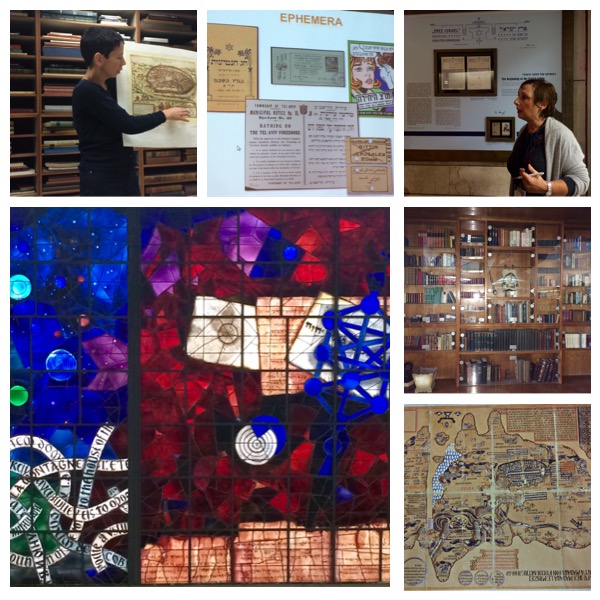
“What is a book? According to the Merriam Webster dictionary it is “a set of printed sheets of paper that are held together inside a cover.”
At this year’s ETAI winter event more than 50 English teachers were taken on a book discovery tour through the impressive National Library of Israel, in Jerusalem. The 120 year old library has a collection of more than 5,000,000 books, 2000 manuscripts, 700 personal archives and 30,000 hours of recordings which are available to the public, at no cost.
As a consequence of my experience I would like to share with you ’10 things I now know about the National Library of Israel’:
- The map room houses the most significant Holy Land maps’ collection in the world
- The Ardon Windows (pictured) represent Isaiah’s vision of eternal peace
- The oldest book in the museum is a Koran, dating back to the ninth century
- Israel’s ‘Book Law’ requires two copies of all printed matter published in Israel to be deposited in the national library
-
The museum is divided into 4 major collections: Judaica, Israel, Islam & the Middle East and the Humanities
-
Gershom Scholem loved to write notes in the margins of his books, which can be seen in the Gershom Scholem Library (comprising 35,000 items related to the Kabbalah, Jewish Mysticism and Hassidism)
- ‘Ephemeral’ means transient or short-lived
- The Time Travel and European Ephemeral collections are made up of letters, tickets, posters, postcards etc., and provide a rich resource of life and culture that can be used for engaging our students in the English classroom
- The library has an educational partnership with the UK, available via an online site, and includes lesson plans and worksheets for use in British classrooms, which could be relevant to our English language classrooms in Israel
- The National Library has a resource rich Facebook page in English which is regularly updated, and provides authentic materials for English teaching.
So why should English teachers teach with Primary Resources? Karen Ettinger, Project Manager for Education at the NLI, explained that primary resources are motivating, relevant, make use of authentic material, enable students to practice 21 century skills, exercise their critical thinking and research skills, whilst connecting them with their past. So if you want to do some, or all of the above I strongly recommend a trip, either physical or virtual, to the National Library of Israel.
Thank you to all of the National Library staff who took us on a journey which made me think differently about the role of the library in the English language classroom today.
Thank you what I need to make useful knowledge from your information and collect the convienent science
Thank you for reading my post and for asking your question. All of the material is available from the website. I have hyperlinked everything bolded in the text, just click on the words in bold and it will take you directly to the places I have referred to.
Good luck searching and accessing materials.
Jane
Hi Jane!
I am so happy we have connected on Twitter, because this is how I have found your amazing blog!
Wow, what a place the National Library of Israel looks like! Thank you for all the information and explanations. So nice to know that Scholem took notes in the margins and now people can actually see them (I do that, too!).
I look forward to reading your previous and future posts, too!
Best wishes,
Vicky
Dear Vicky,
Thank you for your lovely message. You made my day. I loved the ephemeral collection and the maps, which were simultaneously works of art and history.
I look forward to following you more closely now too.
Regards,
Jane